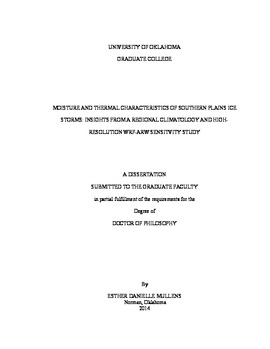| dc.description.abstract | Winter storms, including snowstorms and ice storms, are infrequent in the Southern Great Plains of the United States (SGP), but can produce significant hazard and socioeconomic disruption. During 2000-2010, several severe ice storms impacted the region. These events combined resulted in nearly $800 million in damages, over 30 fatalities, and power disruption to over 3 million homes and businesses. Hitherto, basic climatological information for winter storms in this region remain understudied. This dissertation examines the characteristics of freezing precipitation events for the SGP by developing a regional spatial and synoptic climatology (1993-2011). Thermal profiles conducive to winter precipitation of varying types and intensities are also examined and compared with past literature. A combination of sounding analysis, and Principal Component (PC)/composite techniques are used to derive this climatology. Results identified that the SGP experiences freezing precipitation of varying intensity, but that ice storms to the region are notable for their large above-freezing inversion layer (‘warm layer’) temperatures/depths and mixing ratio. Freezing precipitation occurs most often over the central and eastern domain during December-February, while snowfall maximizes northwest of this zone with broader seasonal occurrence. The synoptic analysis showed that patterns conductive to storms with a pronounced mixed-phase region typically involved topographically aided ageostropic down-gradient advection of cold stable air in the lee of the Rocky Mountains, with an arctic high pressure over the northern/central Great Plains. A mid-level trough and low-level warm air advection provided ascent, and anomalously warm air to the south provided sufficient support for a warm layer. Long-duration ice storms were observed with a slow-moving high-amplitude western trough, direct moisture transport from the Gulf of Mexico, and a ridge over the southeastern U.S.
Based on the climatology and past literature, a hypothesis is proposed that the Gulf of Mexico, as the proximal basin and major moisture source, may impact ice storm severity by modulation of the warm layer profile associated with strongly positive or negative SST anomalies. This hypothesis is tested using high-resolution nested WRF-ARW sensitivity studies with six representations of SST, including the 30-year climatology, a uniform ±2 degrees K perturbation to the control, and a physical upper and lower limit using the SST field for the warmest and coolest basin-average anomalies 1981-2011. Two case studies were utilized corresponding to different synoptic types.
The simulations revealed discernible influence of SST on freezing precipitation, including its temporal evolution and intensity. For the December 9-11 2007 case study, the warm layer formed well prior to the event, associated with persistent southerly flow and a warm anomaly over the southern U.S. The impact of SST on the warm layer intensity was weak in comparison to its existing magnitude, however the atmospheric stability profile was altered such that strongly negative SST produced stabilization above the maximum inversion temperature and markedly reduced precipitation on the first day of the ice storm. A dynamical weakening of the low-level jet and moisture transport in the strongly positive SST case counteracted observed increases in mixing ratio to yield weaker accumulation differences during the second precipitation episode.
For the January 28-30 2010 case study, the impact of SST was more pronounced on the warm layer, which had formed in association with return flow from the Gulf. Warmer SST, especially strongly positive localized anomalies within the fetch of the impacted area, lead to both a moisture induced intensification of precipitation, and increased peak warm layer temperature, leading to changes in the location of freezing precipitation versus rain/snow, especially for Arkansas. Dynamical intensification (weakening) of precipitation occurred as increased (decreased) baroclinicity, warm air advection and latent heat release promoted a stronger geopotential low at 850 hPa, and a strengthened (weakened) low-level jet yielding greater (less) moisture transport.
Despite the differing thermal and dynamical responses, both case studies displayed potential for enhanced icing conditions with warmer SST, while cooler SST produced a marked reduction in severity. The January 2010 event showed greater sensitivity in the location and amount of icing due to the warm layer evolution being more directly connected to diabatic processes over the Gulf of Mexico 24-48 hours prior. Results showed discernible impact even with comparatively small SST perturbations (e.g., climatology versus control) indicating that winter precipitation is sensitive to basin SST anomalies. This work may be of use to forecasters and regional climatologists in gaining situational awareness and recognizing the role of both large-scale synoptic and regional thermodynamic drivers of phase type and intensity. Furthermore, given the observed increases in SST resulting from global climate change, this work provides physical understanding of processes that may impact ice storm evolutions in a warming climate, particularly with respect to the warm layer. | en_US |
